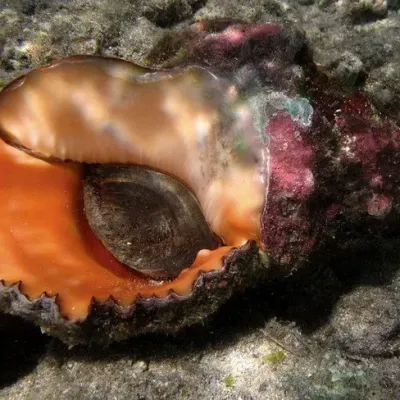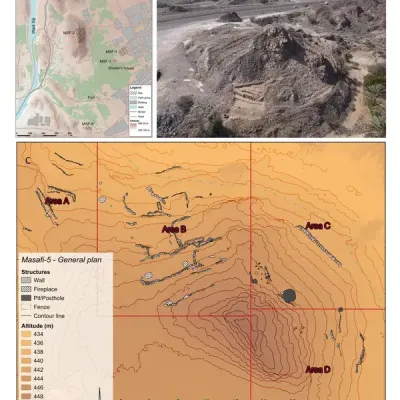Ruth Schuster
Source - https://www.haaretz.com/archaeology/2023-03-14/ty-article/archaeologists-discover-unexpected-enterprise-in-prehistoric-uae-village/00000186-df5a-d25f-a59f-ffffd8760000
 A giant frog snail, one of the 23 species whose fragments were found by archaeologists at Masafi in the United Arab Emirates.Credit: Philippe Bourjon
A giant frog snail, one of the 23 species whose fragments were found by archaeologists at Masafi in the United Arab Emirates.Credit: Philippe Bourjon
Sprawling at the feet of the Hajar Mountains in the emirate of Fujairah lies the ancient village of Masafi. The strange thing isn’t prehistoric people eking out a living in the desert – the sands of the Middle East have been constantly if sparsely populated since time immemorial. The strange thing is this inland town’s seashell processing industry.
Masafi does get some rain in winter, but not much. The emirate averages 354 dry days a year, though in keeping with the climatic times, last July received 21 centimeters (just over 8 inches) of rain in two days. But it has bountiful springs and its settlement goes back to at least the Early Bronze Age, Kevin Lidour of Spain’s University of Cantabria and colleagues report in the journal of Archaeological and Anthropological Sciences.
What did they eat? Mainly the usual for the time and place: terrestrial mammals such as goats, sheep and cattle, Lidour clarifies. They likely also ate whatever wild herbivores they could catch. And they had a taste for giant sea snail.
Unusually for an inland desert site, the dig at Masafi found a substantial number of shells – of which almost 99 percent were marine snails and clams. The other 1 percent found in the layer called Masafi 5 were local terrestrial snails, and we can forget about them.
 A Map of the Masāfī area showing the different archaeological sites investigated by the team.Credit: French Archaeological Mission in the UAE. CAD: A. Havé and J. Charbonnier, Archaeological and Anthropological Sciences, 2023
A Map of the Masāfī area showing the different archaeological sites investigated by the team.Credit: French Archaeological Mission in the UAE. CAD: A. Havé and J. Charbonnier, Archaeological and Anthropological Sciences, 2023
The people seem to have only been eating mainly one species: the giant whelk. But analysis of shell fragments shows they hauled at least 23 different species. And what were they used for? Making tools and fripperies.
It bears adding that the researchers didn’t find many animal bones, but Lidour discounts the importance of that deficiency. He says they did find some in a large pit beyond the terraces where the people actually lived. Garbage pits are known from antiquity. Maybe they were simply neat.
Adore snakes, will travel
Masafi was occupied from the Bronze Age about 3,500 years ago to the Iron Age, about 2,300 years ago, Lidour explains. The terrain is hilly and the people apparently built homes using perishable materials on bedrock terraces, the archaeologists deduce.
They grew food using “oasis agriculture” and developed irrigation systems, as other ancient desert peoples did. They also seem to have developed a nice line in copper smelting, the archaeologists suggest, based on a wealth of evidence including hearths and furnaces typical of metallurgy, as well as copper-based alloys and ingots.
Over 15 years excavating the site, archaeologists found public buildings from the Iron Age that may have served for centralized administration, as well as fortifications, and a shrine dedicated to worshipping the serpent – a common deity in antiquity. (Some even think there is evidence for snake worship in southern Africa 70,000 years ago. Others think the rock is a rock, not a snake statue, and that the interpretation is stretched.) At Masafi, the snake cult was identified based on incense burners and posts decorated with snakes, as reported in 2009 by Anne Benoist and colleagues.
 Specimens of bittersweet clams from Masāfī 5.Credit: K. Lidour, Archaeological and Anthropological Sciences, 2023
Specimens of bittersweet clams from Masāfī 5.Credit: K. Lidour, Archaeological and Anthropological Sciences, 2023
Since the snake was revered widely around the region and beyond, could the cult’s presence at Masafi be taken as evidence of cultural and trading links?
“It is true that more or less at the same time, comparable snake worship appeared in different regions, including in the Levant, Mesopotamia, Eastern Arabia, southern Iran and India,” Lidour said in an email. “But we are still very careful regarding evidence of cultural ties/links. ... According to scholars, the snake worship occurring in Eastern Arabia probably came from strong contacts and exchange with India/Pakistan by the Bronze Age and the Iron Age.”
Grave goods for prehistoric Oman
Okay. What about the seashells, of which the archaeologists report finding “a substantial amount”? They had to have been collected on the coast, which isn’t next door but is just six hours away by foot, the team estimated. Google Maps is helpful.
Charring shows whelks were cooked, and their shells were not found to have been utilized for some other purpose. Regarding the other marine species, it was vice versa: Other mollusks’ edges were sharpened to create a better knife (not a thing found elsewhere around the region). Use-wear analyses suggests the honed edges were used on plant matter, likely to process date palm fibers to make cord, rope, fishing nets, mats, baskets and so on, and even stuffing for pillows and mattresses.
And the mollusks’ nacreous deposits – better known as mother-of-pearl – were used to make pretty things for export.
 Comparisons of use-wear on archaeological (from Masafī 5) and experimental specimens.Credit: K. Lidour with a Leica DM2500 M optical microscope, Magnification × 100; Laboratory platform: IIIPC (University of Santander), Archaeological and Anthropological Sciences, 2023
Comparisons of use-wear on archaeological (from Masafī 5) and experimental specimens.Credit: K. Lidour with a Leica DM2500 M optical microscope, Magnification × 100; Laboratory platform: IIIPC (University of Santander), Archaeological and Anthropological Sciences, 2023
“The tools were apparently used in everyday life at the site, but the adornments seem to have been all exported somewhere else,” Lidour says – not a single complete one has been found at Masafi.
Where to? Some certainly to what is today the Sultanate of Oman, where they served as grave goods, he says. Mother-of-pearl originating in the Gulf waters have been found as far afield as Mesopotamia and the upper Euphrates – at Mari, for instance.
How the trade network actually operated is not known, nor can they state that goodies were directly exported from Masafi to Mesopotamia, he stresses. Likely there were supply chains.
 Mangrove whelksCredit: Marut Sayannikroth / Shutterstock
Mangrove whelksCredit: Marut Sayannikroth / Shutterstock
Meanwhile in prehistoric Pakistan
Altogether, the archaeologists found hundreds of fragments belonging to no less than 23 species, including ark shells, multiple species of clams and oysters; giant frog shells – that’s a thing – cones (conuses), cowries, top shells, conches, turban shells, “worm shells” and more.
The favorites included giant mangrove whelk, black-lip pearl oyster, ark shells and the violet asaphis, the team reports.
 The violet asaphis.Credit: Philippe Bourjon
The violet asaphis.Credit: Philippe Bourjon
Two bittersweet clam fragments bear signs of pigments. Which means? “The bittersweet clams bearing pigments were probably used as small containers for metal oxide-based products – probably cosmetics similar to kohl,” Lidour answers.
The team adds that the smaller species have no nutritional value to speak of. The whelk is an outlier in having as much protein as a tuna steak, they note.
Were the whelks dried for the journey inland? The team points out that if one has a clay jar – and the people of Masafi certainly had pottery – and if one places seawater inside, one can keep the unfortunate gastropod alive for weeks, and it could thusly have been lugged about “fresh.”
 Protein-rich whelksCredit: Bima Nurdin/Shutterstock.com
Protein-rich whelksCredit: Bima Nurdin/Shutterstock.com
In fact, Lidour says, it seems this live mollusk was a favorite in regional trade and for snacks on the road. “There is also evidence for the consumption of fish (dried or salted) at inland sites from the Iron Age onward, but strangely not during the Bronze Age or the Neolithic (when the consumption of fish is only attested on the coast),” he says. But other prehistoric sites in the inland UAE don’t feature shell-transforming workshops or shell tools.
Some ark shell fragments also showed signs of charring, and they’re nutritious too, the team observes. Maybe they too were transported alive in jars.
Intriguingly, some non-whelk shells show signs of “marine erosion” – meaning, the animals had presumably passed away in their natural habitat and were collected postmortem. This shores up the theory that they weren’t taken for consumption but for use as raw material for adornment or knives, which leads to the fact that some of the shell bits clearly show evidence of modification by humans.
 Giant frog shells.Credit: Llez
Giant frog shells.Credit: Llez
As for the gewgaw manufacturing industry, mother-of-pearl has been prized since the Neolithic period in Arabia, and remains so worldwide. The precious substance at Masafi 5 originated in the oyster. The archaeologists note finding both unworked fragments and polished plaques of mother-of-pearl.
No finished products were found, however. Possibly both the copper and nacreous deposits were sold to Mesopotamia, which had a large appetite for both.
Cone spires and giant frog shells were also used to make decorations. The team speculates that Masafi may have had a workshop, albeit a small one, to process frog shells. It has been postulated that unbroken ones could also serve as containers.
Based on comparisons of giant frog shells found in Mesopotamia, southeast Iran, Eastern Arabia and the Indus Valley (in modern-day Pakistan), again the archaeologists believe they can discern ancient trading going back to at least the third millennium B.C.E.
 Different cowries.Credit: Bricktop
Different cowries.Credit: Bricktop
As for cowries and other small gastropods, maybe they were used as game pieces, the team suggests. They’re still used to play mancala, and who can say they weren’t in protohistoric Arabia? We do know that board games go back thousands of years, so maybe pretty seashells were like “special” chess pieces today.
So what have we? The people of prehistoric Masafi imported lots of shells, probably from the Fujairah-Kalba coast, ate the whelks and perhaps a few other types, and turned the rest into knives and other tools such as scrapers. They do not seem to have eaten the terrestrial snails that wandered about. They also exploited the mother-of-pearl.
And then Masafi was abandoned in roughly the seventh or sixth century B.C.E. We do not know why. It needs more research, says Lidour: “It could have been due to the collapse of many terraces where the people have established perishable housing. It could have been linked to a climactic degradation at that time (reported as aridification at the regional scale), which could have impacted the oasis-based economy and lifestyle in the Masafi area. … What I can say for now is that nothing is sure regarding this event.”
 Seashells on the seashore of prehistoric UAECredit: H. Zell
Seashells on the seashore of prehistoric UAECredit: H. Zell